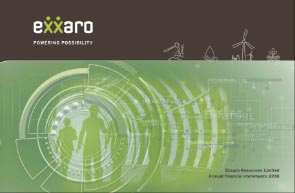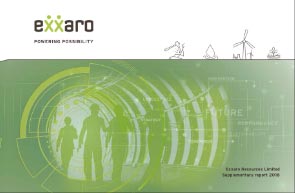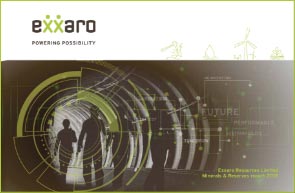Exxaro Resource limited Report Selector 2018




Currently viewing Mineral Resources Report 2018




Currently viewing Mineral Resources Report 2018
The Mineral Resources and Mineral Reserves summarised on Coal Resources are reported as those remaining on 31 December 2018 and compared with the corresponding estimates reported on 31 December 2017. Mineral Resources are reported including Mineral Resources that have been converted to Mineral Reserves and at 100% Exxaro ownership, irrespective of the individual operation or project's attributable shareholding. An exception is our reporting for Gamsberg and Black Mountain, as base metal figures from Vedanta Resources plc represent resources excluding those Mineral Resources converted to Mineral Reserves.
It is important to note that reported estimates are not an inventory of all mineral occurrences identified, but a reasonable estimate of those, which under assumed and justifiable technical, environmental, legal and economic conditions, may be economically extractable at present (Mineral Reserves) and eventually in future (Mineral Resources).
Mineral Resources and Mineral Reserves are estimated on an operational or project basis and in line with the SAMREC Code for African properties, except for Vedanta's property, and the JORC Code 2012 for Australian and Vedanta properties. For Coal Resources and Coal Reserves under Exxaro's management control, estimation is in line with the South African National Standard: South African guide to the systematic evaluation of Coal Resources and Coal Reserves (SANS 10320:2004).
Comprehensive information on each operation that supports the Mineral Resource and Mineral Reserve estimates is provided in the ancillary section.
There is no material change at our Grootegeluk mine for the 2018 reporting period. This is a surface coal-mining operation where a series of parallel benches are advanced progressively across the deposit via a process of drilling, blasting, loading and hauling with truck and shovel fleets. The mining bench definitions in both the Vryheid and overlying Volksrust formations coincide with the geological boundaries, resulting in 14 mining benches for both saleable products and waste. The largest portion of the beneficiated product is power station coal (at 25.8Mt representing 87% of the product stream), dispatched to the Matimba and Medupi power stations. The remnant is made up of several sized metallurgical coal products and semi-soft coking coal railed to local and international customers.
Geological challenges are increasing as the mine advances to the west. The upper top benches are thinning and will eventually discontinue due to weathering, with only a small portion of bench 2 remaining in the next few years. Weathering is highly irregular, specifically in faulted areas, and impacts on mining as well as disrupting downstream beneficiation plant throughput. The impact to date of geological faulting on mining is limited since its influence only occurs over short lateral distances and the effected coal can be mined and routed correctly to the appropriate coal-handling facilities. An increase in faulting, both in offset and frequency, is however observed to the south and north of the current pit and poses a higher risk for future mining. Continuous pit mapping, surface and downhole geophysical surveys and close-spaced open-hole drilling are employed to target geological structure complexity, overburden characterisation and to outline weathering in the upper benches. The high-resolution information obtained is used in proactive mine planning and largely mitigates the various geological challenges.
The geological model is updated biannually, and information from drilling campaigns in 2017/18 will be used to update the geological model in early 2019. A review of the Grootegeluk exploitation strategy was initiated in the last quarter of 2018. The update will incorporate new geological information, consider several expansion initiatives and review the current pit turnaround and backfill strategies. An important project, the Grootegeluk integrated water use management strategy (GGIWMS), also began in the reporting year. The objective is to clearly define all water-related aspects and present a strategy for the optimal use of water throughout the value chain. This project will integrate with the exploitation strategy and is expected to enhance water-use efficiency.
The construction of the GG6 project plant was initiated in 2018. The existing Grootegeluk 2 (GG2) plant historically produced power station coal and the project aimed to convert the single-stage beneficiation plant to a new double-stage plant, namely Grootegeluk 6 (GG6). The project introduced a new small-coal beneficiation plant (SCP), enabling fragments smaller than 10mm to be processed and improving plant fines beneficiation using reflux classifier technology. Associated benefits are the addition of a dewatering plant, an upgrade of the two tip-bins to higher capacity and expanding the current stockyard. The project aims to triple the capacity of the current GG6 plant, producing a high-ash semi-soft coking coal (SSCC) suitable for the export market, as well as power station coal.
Overburden mining at Grootegeluk is evolving in volume and complexity. A study to address this challenge is the in-pit crushing and conveying overburden (IPCC OVB) project. The project investigated options to replace the existing load-and-haul mining method with a more cost-effective alternative by considering mining and transporting overburden material via a bulk-materials handling system. The prefeasibility study (PFS) is still under way to identify the preferred alternative. An approval for ministerial consent (section 102) was submitted in September 2017 to include two mine-dump areas that currently fall outside the mining right. Approvals are pending and the legislative process following the submission is under way.
Exxaro is considering options on four prospecting rights some 30km north-west of Grootegeluk mine. These prospecting rights are grouped in two projects, Waterberg North and Waterberg South, and include around 3 billion tonnes of Inferred Resources. Renewals for all the rights have been granted and Exxaro is currently studying the strategic fit of these rights.
Figure 4: Exxaro’s mining and prospecting rights in the Waterberg |
 |
Arnot, an Eskom tied mine, is in closure after the coal-supply agreement (CSA) with Eskom ended on 31 December 2015. The mine produced thermal coal for over 40 years, using various mining methods, predominantly bord-and-pillar (currently mechanical), open-casting and short-walling between 1995 and 2005. A prefeasibility study on the commercial viability of Arnot in 2016 found that there are several areas that can be profitably mined for the thermal coal market. However, due to the absence of a confirmed contractual service agreement (CSA), no Coal Reserves are declared.
During the reporting period, Exxaro disinvested from the North Block Complex (NBC) coal mine and adjacent coal project of Paardeplaats and are therefore not included in the 2018 statement.
Matla, an Eskom tied underground operation, is some 20km west of Kriel in Mpumalanga. The operation is an underground mine that extracts coal through three underground mines. Mining activities at Mine 1 ceased in 2015 due to pillar instability but a relocation study that entails developing a new box-cut and tunnels to access Coal Reserves was completed and received approval in principle from Eskom in the reporting year. Mine 2 and Mine 3 use both bord-and-pillar, continuous-mining (CM) and shortwall (SW) coal-mining methods, but geological conditions to support SW mining methods are decreasing and will end. A project to replace the soon-to-be redundant SW equipment with its CM equivalent was presented to Eskom.
Mines 2 and 3 produce coal from seams 2 and 4, which is blended to provide the quality of product necessary for Matla power station. Both coal seams' mineable reserves are rapidly diminishing, and both mines will have to access additional reserves. Two expansion projects, consisting of a decline and incline (respectively) below and above current workings at Mine 2 and 3 were approved by Eskom in 2018, unlocking seams 2 and 4 Coal Reserves. A new vent shaft at Mine 3 to support the expansion awaits Eskom approval.
Matla accesses Coal Reserves under challenging geological and mining conditions. Thinning coal seams, variability in coal quality and roof conditions due to the impact of intrusive dykes and sills, as well as geological faulting, present challenges for coal extraction in a number of mining sections. Focused exploration activities, including surface and downhole geophysical surveys and vertical and horizontal drilling, are employed to proactively outline and align the impacts on mine planning. New information from the 2017/18 drilling campaign and results from a revision of historical information were used to update the geological model and scrutinise the classification of Coal Resources. The results improved the outline of the Indicated and Measured Resource strings, and this refinement is reflected in the movement between the various Coal Resources categories. The change in the resource base resulted in a 5.7% decrease in the Coal Reserve after the LoMP was revised. The reduction of pillar-extraction recovery based on the review of the extraction process to enhance ventilation and safety as well as considering actual extraction figures in the reporting period resulted in a further 13% decrease in Coal Reserves.
In line with Exxaro's commitment to unlock value, an expansion project to extend the life-of-mine of Leeuwpan, an open-pit operation in Delmas, Mpumalanga, by ten years was implemented in 2018. The updated plan incorporates changes in the price structure of the export market, with higher prices for lower-energy products leading to higher yields. The R500-million optimisation project will enhance Leeuwpan's performance by better aligning access roads to the site, as well as upgrading the existing plant and producing high-quality thermal and metallurgical coal for domestic and export markets. The road relocation and box-cut of the expansion project were successfully concluded in the reporting period. An investigation surrounding the OI reserve resulted in unlocking additional Coal Resources (~2.7Mt) and are included as Probable Reserves in the LoM until all environmental approvals are secured. Significant dyke activity and a prominent dolerite sill that overlies both the resource blocks of UB and OI (Leeuwpan expansion), negatively affecting both slope stability and coal quality, are investigated through open-hole drilling and down-hole geophysical surveying. The impacts are proactively accommodated in mine planning.
Figure 5: Exxaro’s mining and prospecting rights in Mpumalanga |
 |
The ECC complex comprises the Dorstfontein, Forzando and Tumelo operations (figure 5). Dorstfontein complex lies just north-east of the town of Kriel, in Mpumalanga. The complex comprises DCMW (West), an underground mine, and DCME (East), an open-cast operation, as well as Rietkuil (Vhakoni), an adjacent project for which approval is pending of a section 102 of the Mineral and Petroleum Resources Development Act (MPRDA) to incorporate this right into the DCME mining right. New information (130 holes) triggered an update of the geological model in 2017. A revision of the LoM in the reporting period, specifically considering the 2017 geological model, resulted in a significant amount of seams 2 and 4 material being included in underground Coal Reserves. The DCMW seam 4 project was implemented in 2018, unlocking seam 4's lower Coal Reserves through an incline in existing mine infrastructure. Expansions of the Dorstfontein assets illustrate the continuous and successful drive to unlock value for ECC.
The Forzando complex (FZO), a part of ECC, is 10km north of Bethal, and just south of the Dorstfontein complex. FZO complex comprises two underground mines, Forzando North (FZON) and Forzando South (FZOS), and both mining rights were executed in 2013 for a period of 16 years. Forzando accessed some historical workings at FZON (under care and maintenance since 2014) successfully in the reporting year, increasing production and quality of the overall coal product mix. Mining in general is affected by geological faulting and dolerite (sill and dyke) activity, resulting in poor roof conditions and restricting access to potential resource areas. These challenges are thoroughly investigated and accommodated in mine planning and the team is addressing the impact through focused infill drilling (characterisation) and effective grade-control practices (managing mining losses).